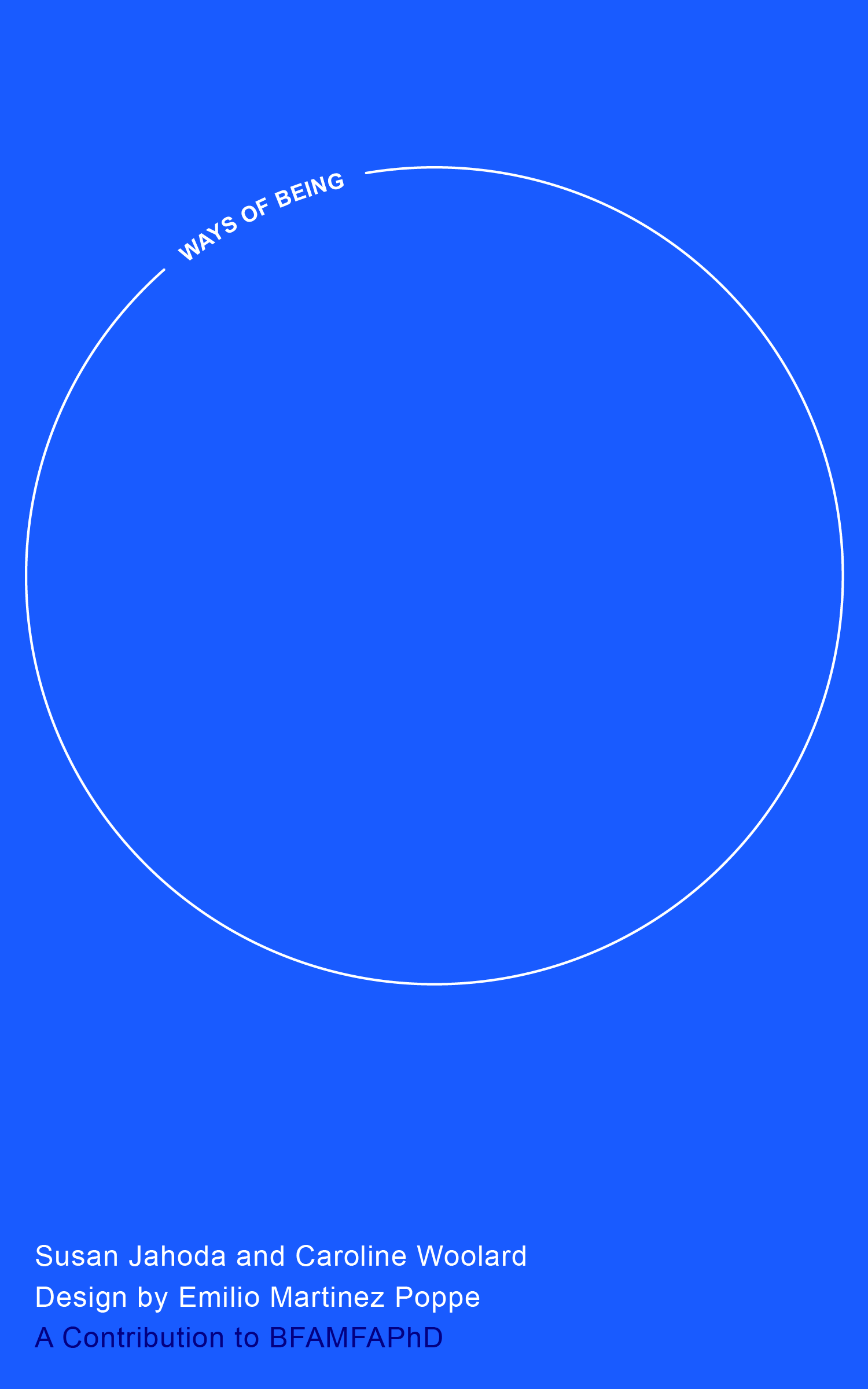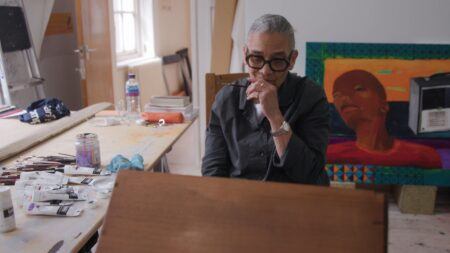Deep Focus
Ways of Being: Introduction

Caroline Woolard, Susan Jahoda, and Emilio Martinez Poppe. Deck of Cards from Ways of Being. Interactive website, 2016-present. Made as a contribution to the collective BFAMFAPhD.
What educational approaches are essential to an era of post-factory production and decentralized distribution, an era that the social theorist Jodi Dean calls “communicative capitalism”? If the nineteenth-century capitalist imperative was to produce, then today it is to communicate. In this era of services, systems, and networked information, what models are necessary to bring visual-art education into the twenty-first century?
In our book, Ways of Being, we investigate artists’ relationships to systems of production: how projects are made, how projects circulate, and how expressions of power are encoded in a wide range of approaches to production. We hope that this book will help artists to align their projects to relevant systems of production and circulation. Readers might think of our book as a kind of art class.
We imagine that students decide to take art classes in order to:
- honor their imagination and curiosity,
- develop the rigor and patience, necessary to make anything,
- trust their ability to turn ideas into reality, and then to
- implement their ideas in dialogue with others, and
- acquire skills to sustain the livelihood of imagination, curiosity, rigor, patience, and dialogue about art.
Why do most art classes make these points seem impossible? What are students being trained for? Where will students go with, say, knowledge of the discipline of painting or sculpture, and the ability to paint or sculpt, but no understanding of the mechanisms that enable their projects and ideas to circulate in the world? How can art students make a living and find meaningful work after their education when courses on professional practices sit on the margins of the curriculum, if they exist at all? Such classes are often taught with the presumption that all students want to show their projects in for-profit galleries, will be able to get their projects shown in for-profit galleries, and will make a living by selling projects through those galleries. Another premise of these courses is that students want to get a teaching job, will be able to get a teaching job, and will be able to making a living with that teaching job.

Caroline Woolard, Susan Jahoda, and Emilio Martinez Poppe. Support Workshop. Facilitated workshop about the care and maintenance that makes projects possible. Made as a contribution to the collective BFAMFAPhD.
The assumptions above do not represent the ambitions of many students, and, even when they do, it is widely acknowledged that artists with gallery representation do not make a living from the sale of their projects.1 Likewise, the majority of art faculty is comprised of adjunct workers whose wages make for a precarious living.2 It is deceptive to suggest that there is a market or a community that already exists for artists’ projects, one that is not actively created by artists. So, what is the role of an art education, and how can students of art be trained to find fulfilling livelihoods where their projects matter?
Luckily for artists and for art departments, corporations, and social-justice initiatives are turning to artists for their capacities as divergent thinkers who can embrace ambiguity and articulate contradictions in order to imagine plausible futures. Chris Newfield writes that all students, whether they take art classes or not, need “to be more inventive, more craft-based, more like artisans and less like assembly-line workers.”3 This is because, in the “knowledge economy” of networked information technology, students are more likely to invent a job that they love than to get hired for one.4 The job that art students create will involve the arts, even if it is not in an arts-related field.5 If students cannot make jobs for themselves after leaving school, they will work in the service industry, earning wages that have not increased since the 1970s.6 Even the World Economic Forum’s report on the future of jobs states that “social skills—such as persuasion, emotional intelligence, and teaching others—will be in higher demand across industries than narrow technical skills, such as programming or equipment operation and control.”7 Students of art need to be prepared to critically assess the employment of art and of artistic techniques by institutions and to find uses for art that are aligned with their ambitions, to create the worlds they want to live in.
Our book is premised on a belief that artists need to be taught to create living relationships between their intellectual interests and the people and groups around them. Again, one needs to be taught ways of being in the world.
We ask students:
- Why are you here?
- What are your intellectual interests?
- What skills, relationships, and types of knowledge will you need to acquire in order to implement your projects both in school and after school?
- What does this era want?
When students can answer these questions, they can begin to connect life in school with life after school—to connect life as an artist with life as a person in the world. They can identify and intervene in daily economies and in relationships with people.

Caroline Woolard, Susan Jahoda, and Emilio Martinez Poppe. Ways of Being book cover. Made as a contribution to the collective BFAMFAPhD.
We believe that an education in art must be as much about ways of being in the world as it is about ways of seeing and ways of making. We are writing this book for people who want a holistic art education; an education that includes how to be both more fully present with themselves (ways of feeling) and with others (ways of relating) and to understand the conditions and contexts that inform the decisions they make in their production process. The term holistic means that the parts of any given system are intimately interconnected and are understandable only in relationship to the whole. For example, how can one talk about making a new project without talking about labor conditions? How can one talk about labor conditions without talking about payment? It’s time for artists to address not only their artistic gifts but also their labor, their well-being, their budgets, and their storage units. We wrote this book for individuals who want a holistic art education, which includes how to be more appreciative of oneself and others and to understand the conditions and contexts that inform decisions within the process of producing art.
This book aims to help a range of artists—art students, artists who have quit formal educational structures, and self-taught artists—to identify what they care about and connect it to a post-factory world that is interdisciplinary and filled with networked information technology. If artmaking is a lifelong practice of seeking knowledge and producing art in relationship to that knowledge, why wouldn’t we teach students of art to identify and intervene in the systems that they see around them? Why wouldn’t we teach students of art about the political economies of art education and art circulation? Why wouldn’t we invite students of art to actively fight for the implementation of the art infrastructure that they want?
Ways of Being is a book, a deck of cards, and an open-access website that aims to provide a guide for artists and arts educators to: (1) understand the social lives of artworks, using systems thinking and life-cycle analysis; (2) assess the social conditions in which artworks and artists live, using social-ecological models; and (3) integrate collaborative practices that emphasize social-emotional intelligence into visual-arts pedagogy.
More information is available at: https://bfamfaphd.com/#topic-teaching
1. How’s My Dealing? An Index for Artists, 24-hour Live Service.
2.Christopher Newfield, “Humanities Creativity in the Age of Online,” Occasion: Interdisciplinary Studies in the Humanities 6 (October 1, 2013): 11.
3. Newfield.
4. Newfield.
5. “Census Report,” BFAMFAPhD.
6. Newfield, 3: “From 1945 to 1975, a student could go to college, use knowledge to increase his or her productivity, and assume that this increased productivity would be rewarded by increased pay. After 1975, worker productivity continued to increase, but pay did not.”
7. World Economic Forum, “The Future of Jobs: Employment, Skills and Workforce Strategy for the Fourth Industrial Revolution,” Global Challenge Insight Report, January 2016.
